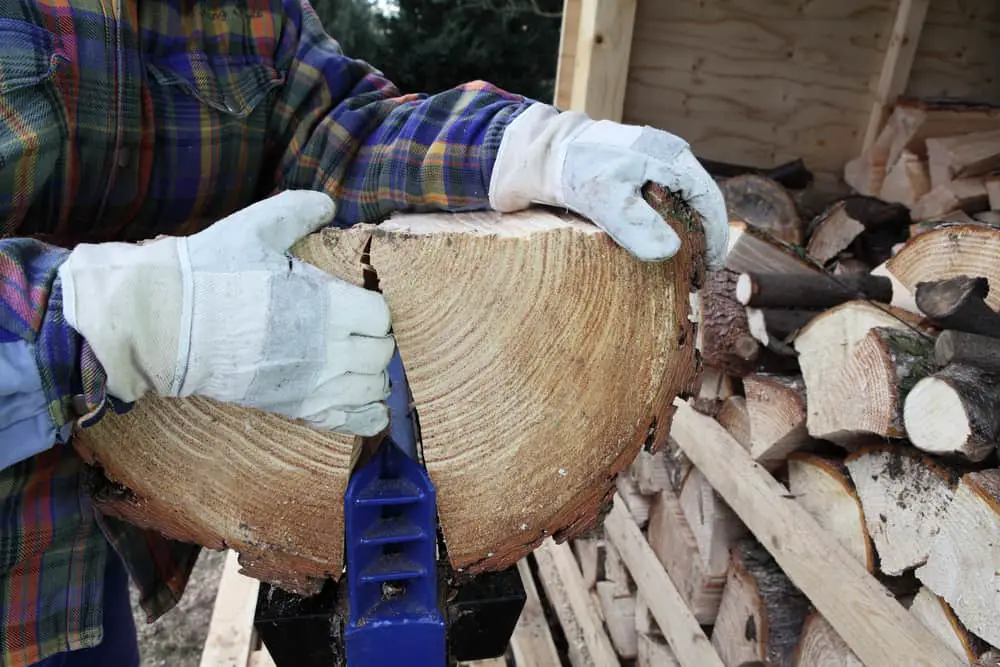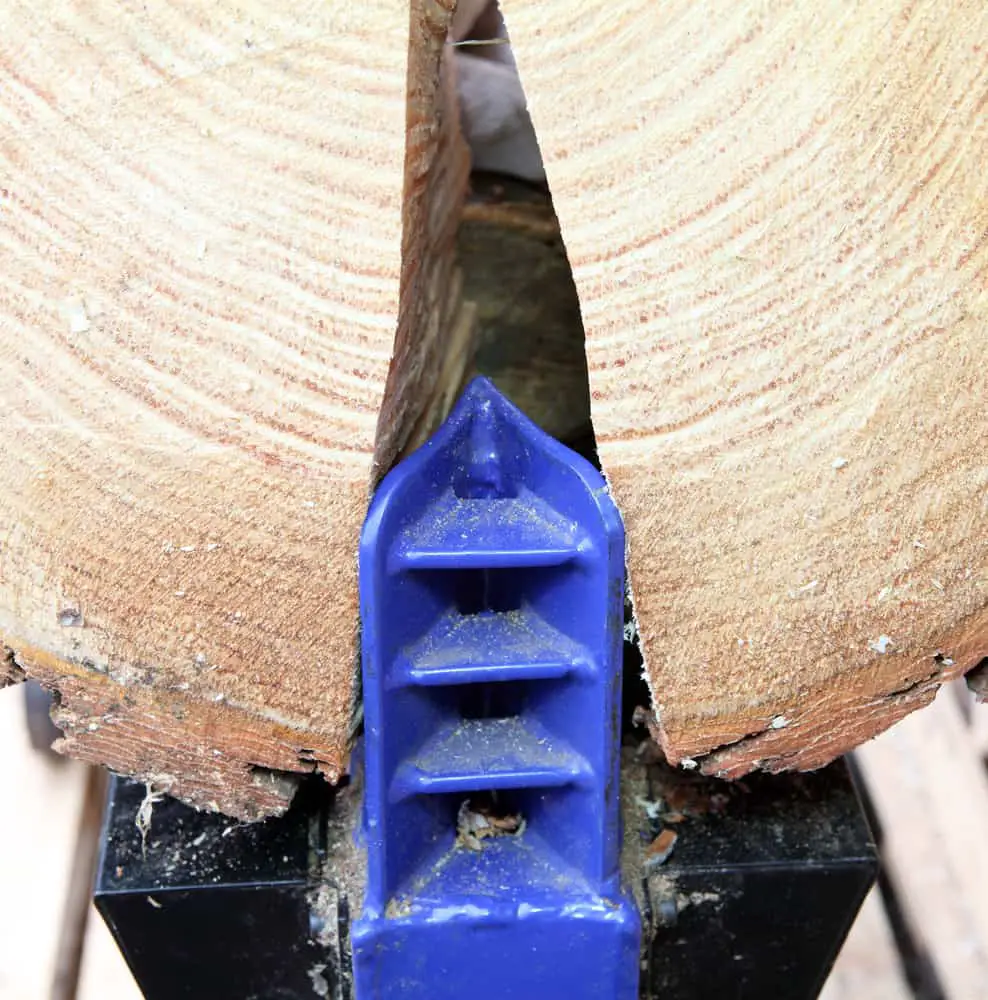Log splitters are used to cut the wood into smaller pieces. The wood can then be used for making paper, firewood, small planks, and several other useful items.
They’re considered simple machines, which means they don’t have several moving parts.
So, what type of a simple machine is a log splitter?
Log splitters are wedges. This means that they have a pointed section to slice through wood. The back is flattened and much more durable to prevent the machine from breaking by the force of its action.
In order to understand more about simple machines, log splitters, and wedges, let’s check out the details below.

Related Reading: How Much Does a Log Splitter Weigh?
What Type of Simple Machine is a Log Splitter?
As mentioned above, a log splitter is considered a wedge. It falls into the same category as most axes, splitting wedges, lift wedges, and many other tools.
You can use a log splitter to dice wood much quicker than you’d be able to do it by hand, and some of the cheapest log splitters still get the job done.
What is a Wedge?
A wedge is used to cut an object down the center.
They usually make clean cuts, rather than bluntly breaking apart an item.
Wedges are used in almost every household since they’re much more common than log splitters and lift wedges.
Here are a few of the most common wedges:
- Knives fit into the wedge simple machine category. This includes butter knives, steak knives, chef’s knives, pocket knives, and everything in between.
- Axes are used to split objects such as wood, metal, plastic, and other things. They’re considered wedges as well.
- Door stoppers are technically referred to as wedges. Although they’re not used to cut, dice, or separate, door stoppers maintain a wedge shape to perform a function.
- Nails are also known as wedges. Although they’re not a triangular shape like the other wedges above, nails use a point with a solid back to hold it in place.
- Farming equipment uses quite a few edges as well to remove crops, till a field, and various other functions.
A wedge is an item that’s designed to separate an object. It has a thick end that slowly turns into a sharp surface at the other end.
By definition, teeth are also considered wedges. Although they’re not a man-made tool, teeth are used to separate objects, and they fit the description to a point.

Wedges are much more efficient when they’re longer and have a sharper, thinner tip. This is the reason that people often sharpen knives, axes, and other wedges.
Spears, swords, arrowheads, and many other tools have been used for thousands of years.
It’s safe to say that wedges have shaped the way we deal with situations daily.
Even in modern times, the wedge shape is incorporated into cars, planes, and other vehicles.
The sharp point allows the vehicle to cut through the air, increasing its aerodynamics and reducing the resistance encountered by the driver or pilot.
What is a Simple Machine?
Simple machines are defined as any tool that’s used to separate or change the direction of another object by using force.
They’re generally much easier to use, and they don’t have numerous moving parts.
For example, a hammer is a simple tool, as is a wheel and an axel. Bigger jobs require bigger machines or tools, typically.
Here’s a list of simple tools that people use every day:
- Ladders are considered simple tools because they allow us to move in a direction by using the object to propel ourselves upward.
- Pulley systems, such as the ones used on flagpoles, are also simple tools. By raising the flag into the air with a single motion, they fit perfectly in the category.
- Levers and balancing systems are other examples of simple tools because they raise and lower items depending on the weight and force applied by a motion.
- Slides are also simple tools. By moving quickly downwards from gravity, let create a motion naturally. The same applies to ramps and stairs in the opposite direction.
- The lids on each jar in your house is a simple tool because it’s used to separate or reattach onto the jar. It’s considered a ‘screw’ simple tool.
- A common lever simple tool used often is the backside of a hammer. Its purpose is to remove nails by driving force from one side, lifting the nail, and separating it from the surface that it was hammered into.
As you can see, there are dozens of simple tools that most people are familiar with.
Your car uses wheels, you probably use spoons, forks, and knives to eat food, and the steps around your house are inclined planes that allow you to move up and down.
How Does a Log Splitter Work?
Log splitters might seem complicated, but there’s a reason that they’re considered simple machines.
The wedge is driven and powered by either an electric or gas-powered motor.
As the pressure of the oil builds up, the operator can use it to shoot the wedge forward to split a log.
There are six parts to a log splitter that allow it to perform its job:
- An engine
- A hydraulic pump
- A valve
- A hydraulic cylinder
- A tank
- A filter
As you can probably imagine, log splitters are some of the most straightforward hydraulic-powered machines in the industry.
You won’t have to worry about dozens of moving parts, although they’re each fairly heavy.
The engine of the machine pushes fluid into the valve as the pressure builds up. The fluid is stored in the tank, which is where the engine pulls it from.
Two separate pipes connect to the valve on either side, both of which are attached to the hydraulic piston.
When you want to use the log splitter, you pull on the lever.
This motion allows the fluid to drive the cylinder, which moves the wedge into the direction of your choosing. Basically, you’re releasing the built-up pressure of the fluid to drive the splitter into the wood.
The sole purpose of the filter is to catch debris and other things that get caught in the splitter.
Rather than jamming the moving parts, you can remove the filter and clean it off to prevent future problems from happening.
The maintenance schedule of a log splitter is simple. Follow these suggestions to keep your machine running for many years to come:
- Clean the filter after each use. Even if you only slice one log, it’s a good idea to get in the habit of always having a debris-free filter. When the filter gets too clogged, it can slow the machine down.
- Change the oil as needed. Every machine that uses oil (including cars, lawnmowers, and other common machines) needs to have an oil-change frequently. Follow the specific instructions of your model.
- Wipe down the log splitter after every time you use it. Wood chips, dust, and dirt can build up along the edges of the machine, causing issues down the road.
Conclusion
Log splitters are simple machines that don’t require a vast amount of knowledge to operate and maintain. If you want to build a log splitter yourself, experience and knowledge become much more important.
They’re perfect for cutting wood to use as firewood, wooden planks, and other items.
They’re easy to use, and they’re essential if you live in wooded areas. They can pose some danger so safety precautions should be followed.
Here are a few takeaways from the post:
- Log splitters are classified as wedges.
- They have six main parts that operate the machine.
- You can maintain your log splitter by cleaning the filter, wiping it down after each use, and changing the oil according to its schedule.
- Simple machines are used daily by almost every person.
